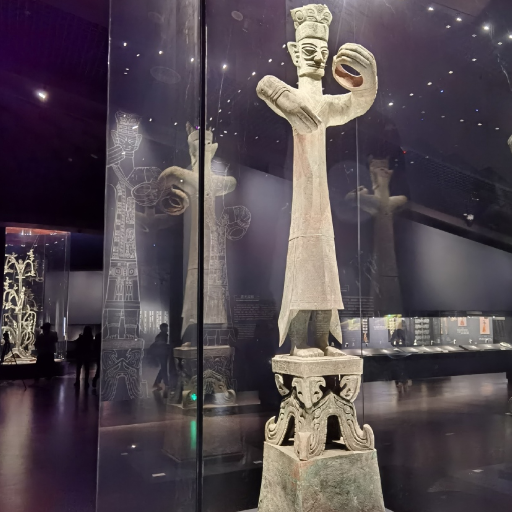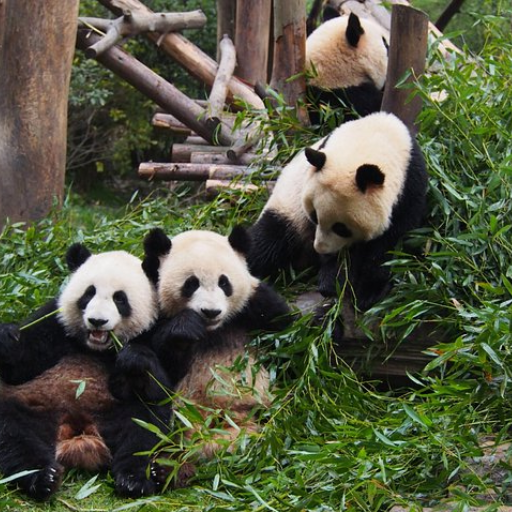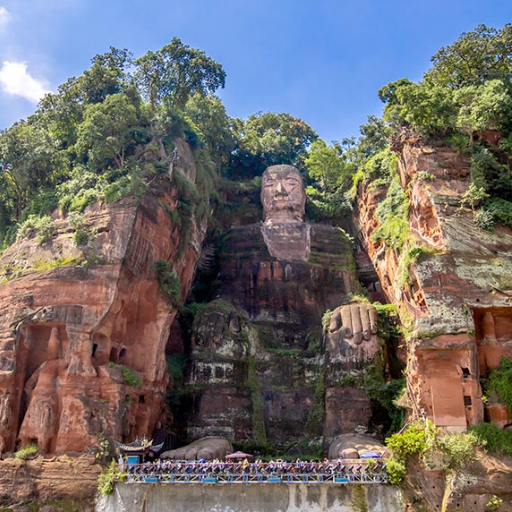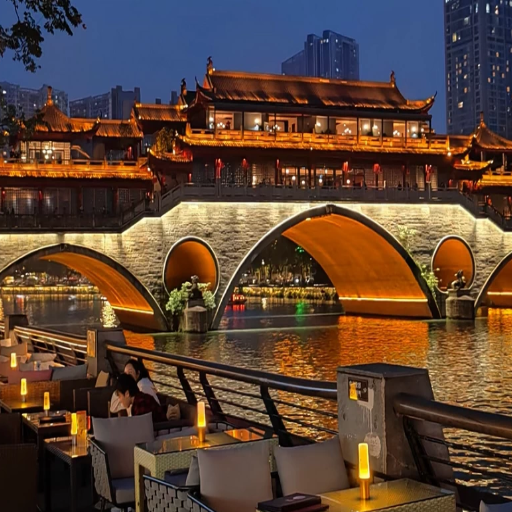As the capital of Sichuan, Chengdu is a city of great historical importance, including modern infrastructures and vibrant cultural sites. Chengdu is well-known as the hometown of the cute giant Pandas and is also considered a food heaven. Chengdu is a travel destination for many explorers but is not very common globally. Chengdu also has its renowned and respected Sichuan cuisine, ancient teahouses where you can sit back and do nothing leisurely, and much more. This ensures each tourist can relish Chengdu with great affection. In this blog, you will discover the most important places to visit in Chengdu and Chengdu’s uniqueness, which will aid you in creating timeless memories.
What Are the Must-See Chengdu Attractions?

Exploring the Chengdu Research Base of Giant Panda Breeding
The Chengdu Research Base of Giant Panda Breeding is a globally iconic institution specializing in the breeding and research of giant pandas. It is located about 10 kilometers north of Chengdu’s city center, covers nearly 247 acres, and is designed to sustain a natural habitat for pandas. These friendly animals can be seen feeding, playing, or resting in specially built-enclosures. Pandas can be seen engaging in various activities, such as feeding, playing, and relaxing within their enclosures.
In addition, there is a panda museum and a research center where exhibits and programs focus on conservation and breeding technologies. The base is equipped with advanced technical parameters, such as optimal habitat conditions, including temperatures between 18 and 24 degrees Celsius, and is best suited for pandas. Careful diet planning is also used to maintain the pandas’ health, as the primary food provided includes specially made supplements, bamboo, and fruits. A visit to the base creates a rare chance to appreciate the work done to preserve an endangered species whilst enjoying the grandeur of the giant panda.
Discovering the Historic Jinli Street
Jinli Street in Chengdu, China, is a well-known tourist destination that has long been recognized as the ‘historical symbol of Sichuan Province.’ Its history dates back over 1,800 years, when the region was part of the Shu Kingdom in the Three Kingdoms era, and it is said to be one of the earliest subsequent quarters of trade in that area. It has ancient commercial street features, with modern attractions and structural styles. This stunning fusion of culture makes Jinli Street one of the most unique places in the world.
Built-in the Qing Dynasty architectural style, the buildings on the street have wooden tiles, fierce decorations, and beautiful ratoon roofs. Tourists who walk down Jingles Street have endless options for purchasing handicrafts, including but not limited to elaborate Sichuan embroidery, glued paper lanterns, and expertly crafted calligraphy brushes. The street also boosts Sichuanese street food stalls selling delicious mapo tofu and spicy dan noodles, which give visitors a real-life experience of the exquisite food culture of this province.
Alongside shopping and dining, Jinli Street is a venue for engaging in Sichuan’s cultural traditions. People can enjoy shadow puppetry or write calligraphy at quaint teahouses while tasting local teas. The lively atmosphere of the street, coupled with its historical importance, offers an unforgettable experience for those seeking to learn about the culture and history of Sichuan.
Unveiling the Secrets of the Sanxingdui Museum
At the Sanxingdui Museum, located in Chengdu, Sichuan Province, stands one of the most significant archaeological finds in China – the ancient Shu civilization over 3,000 years ago. Its astonishing collection boasts two grand sacrificial pits discovered in 1986, which were filled with various artifacts like bronze masks, jade bottles, golden scepters, and exquisitely carved statues. The bronze masks, vessels, and other remnants possess an unmatched technical artistry and craftsmanship for their time.
Bronze Masks:
These masks were constructed using a high-purity bronze alloy representing advanced metallurgical techniques, indicating that the civilization possessed advanced tooling.
Some of the masks famously known as ‘big masks’ have a whopping width of 1 meter, showcasing their large-scale rounded foundry casting capability.
Golden Sceptre:
The workmanship on the golden scepters indicates that they are composed of pure and finely refined gold. This directly symbolizes that the civilization had easy access to large deposits of gold and advanced methods of gold refinement.
The golden scepters were likely ceremonial objects representing power, control, and divinity.
Jade Artifacts:
These artifacts are believed to have spiritual significance and were often used in rituals, indicating their importance to the civilization.
The splendid vessels are carved with elaborate artistry showcasing the advanced techniques of jade working that the civilization mastered.
Earliest Silk Traces:
The collection highlights the stronger beginnings of silk production in the region, with silk thread remnants discovered in the pits.
Every single artifact demonstrates the Shu people’s innovative nature and rich culture and provides valuable insight into their societal organization, religious beliefs, and relationship with other cultures. The Sanxingdui Museum continues its efforts in research and excavation to uncover the remaining pieces of this progressive ancient civilization’s puzzle. Tourists at the museum can appreciate the remarkable relics and further learn about the heritage of the Shu civilization.
How Can I Make the Most of a 1 Day Trip to Chengdu?

Essential Stops in Chengdu City Center
Chengdu can be quite informative and fun at the same time with a proper one-day itinerary; Chengdu has multiple sightseeing features. Below are a few features that you may consider:
Chunxi Road: At the start of the day, you may visit Chunxi Road, the most famous food and shopping place in Chengdu. You can try the Sichuan breakfast offering, which includes Dandan noodles or the famous Sichuan steamed buns. You can also stroll through the site and soak in the native culture.
People’s Park: Your next stop is the People’s Park, where you can enjoy the calm, cooling aspect of Chengdu. Relish authentic Sichuan tea from a famous tea house and soak in Chengdu’s slow-paced lifestyle. The park also contains a myriad of activities, such as dancing and even music concerts.
Wuhou Shrine: For travelers interested in learning about history, the remarkable shrine of Wuhou will give you a history lesson on the central characters of the 3 Kingdoms from old China. The Wuhou shrine is enhanced by exquisite architecture and beautiful parks, which adorn gardens, making it worth visiting.
Jinli Ancient Street: A step away from Wuhou shrine, Jinli Ancient Street is also famous for THE Chendu life. Chengdu stands as the premise. You can explore the street, try various local cuisines, purchase souvenirs, and appreciate the stunning traditional Chinese buildings.
Kuanzhai Alley: Treat your afternoon by walking through Kuanzhai Alley, which is filled with boutiques, cafes, and restaurants. This historic district is perfect for taking wonderful photographs while appreciating Chengdu’s ageless charm.
Chengdu Research Base of Giant Panda Breeding: At the end of the day, head over to the world-renowned panda base, which is located not far from the city center. Make sure to spend at least two hours admiring the gentle giants as they play and help with conservation efforts. Come by early in the afternoon to see them during their most busy time.
By arranging your stops effectively, you can take full advantage of your limited time to experience Chengdu’s rich historical, cultural, and natural beauty.
A Quick Visit to the Wenshu Monastery
Wenshu Monastery, or Wenshu Yuan Monastery, as it is colloquially referred to, is one notable temple in Chengdu. Known for its breathtaking scenery and the calm nature of the temple, it is a great getaway from the city’s hustle. The monastery was built during the Tang Dynasty, which makes it one of the oldest monasteries in Chengdu. The term “Wenshu” is translated as the Buddhist Bodhisattva of wisdom, which shows the temple has devotion towards intellectual and spiritual growth.
To gain the perfect experience of the monastery, it is suggested that you visit while keeping 1-2 hours free so that it is possible to appreciate the calm gardens and moments of reflection in the setting. Noteworthy attractions at the site include the sculpted hall with a thousand statues of Buddha or the main entrance and its marvelous wooden walls and carvings. These areas may seem congested around mid-day but offer stunning views and a peaceful atmosphere early in the morning. Moreover, a tea house at the monastery serves rich Chinese tea, which gives a foot into the cultural vibe.
The Wenshu Monastery is an important temple in Chengdu for those interested in history and spirituality. Visitors wishing to participate actively in these ceremonies are welcome to join. The monastery is accessible, making it easy to include on a day trip to Chengdu. Don’t forget your camera and walking shoes to get the most out of your visit!
What Are the Highlights of a Chengdu Tour?

Visiting the Leshan Giant Buddha
According to ancient records, the Leshan Giant Buddha was sculpted out of a sandstone cliff during the Tang Dynasty in 713 AD, making it over a thousand years old. The beautiful carving of the Leshan Buddha stands tall at a staggering 71 meters—the world’s tallest stone carving of a Buddha. The intricate details of this statue within arm’s reach almost seem as though it were sculpted yesterday.
Some must-sees include the Lingyun Plank Road, which offers gorgeous views of the surrounding area and helps you appreciate the statue’s astonishing details from a distance. You can also learn about the marvelous drainage system that has prevented water from corroding the statue for decades. The site is located at the confluence of the Min, Dadu, and Qingyi Rivers, symbolizing the statue’s significance as a guardian to the tourists who pass through these rivers.
Visitors looking to appreciate the humongous structure can do so through multiple viewpoints, giving a more flexible approach to seeing the site. My favorite is skimming the stunning base of the statue and getting up close as the boat takes you around. For additional scenic views, the entry fee of CNY 80 (USD 11) separates the central area from the ship tour for those willing to pay more.
Exploring the Taoist Mountain of Qingcheng
Qingcheng Mountain is a famous Taoist Mountain and is known as one of the birthplaces of Taoism in China. It has ample historical significance and Taoist spiritual value. The mountain is divided into two sections: Front Mountain and Back Mountain. The Front Mountain has a variety of region’s temples, including ancient Jianfu Palace and Shangqing Palace. The ancient temples are located on the Back Mountain, famed for its marvelous naturalistic landscapes.
For visitors to Qingcheng Mountain, the available entrance fees are CNY 90 (USD 12) for the Front Mountain and CNY 20 (USD 3) for the Back Mountain. In addition, there is a CNY 60 (USD 8) cost per adult for the use of the cable- car in both directions. The mountain has a likable trail that caters to all skill levels. Upon reaching key trekking points, comfortable hiking shoes are a necessity. Visitors traveling during the summer months should be sure to hydrate and wear sunscreen. An attempt to northwest Qingchengshan village is made to place the experience of watching the mountains between nature’s thumb region that is indescribably soothing and eye-opening.
Experiencing the Sichuan Opera Performance
Sichuan Opera is a cultural gem of Sichuan Province. It enchants its audiences with colorful attire, expressive movements, and various performance styles. Performers vividly depict fiery ancient stories using face changing (Bian Lian), a technique in which performers change masks at a superb speed, and fire-spitting. These two techniques showcase the performer’s skill intertwined with storytelling.
Face-changing technique: As a performer, he relies on swift hand movements and tricks of ingenious design in the mask and costume. You are forced to learn this through tedious training aimed at perfecting the synchronization of your movement with the passage of time; constant movement is easy, but synchronizing full-body movements and timing is difficult.
Musical instruments used: Ancestor gold, fiddle, which are lutes twirled vertically, and drums; these described instruments evoke memories of parents crying and singing, increasing the mood for action.
Stage effects: The lighting is lively, and the movement of fireworks is timed to the story of the opera, working to raise the drama of the scenes.
Visiting the Sichuan Opera will expose tourists to China’s excellent combination of innovation and ancient culture, art, and history.
Where Can I Experience Authentic Chengdu Nightlife?

Enjoying Drinks at Anshun Bridge
Bridges often connect regions, but their design is as important as their purpose, like the Anshun Bridge in China. Its phenomenal confluence of historical and modernized culture had me entranced right from the start, and I was not disappointed, to say the least. Anshun Bridge is an arch structure illuminated at night, which adds to the beauty of the Jin River over which it is suspended. This area is also a hot spot for Chengdu’s nightlife and for sipping on some signature cocktails or Sichuan Tea. These areas are busy like downtown Tokyo, but still manage to emit a relaxing vibe, the conversations fill the air, and add a charming ambiance while the bridge beautifully reflects in the river.
Like icing is to a cake, lighting compliments and adds the final touches to the crane. Indeed, It is like the cherry on top, particularly the bridge’s well-positioned LED lights that serve the dual purpose of preserving the environment for Anshun’s exquisite details and consuming less energy. Undoubtedly, the acoustics in this area are pleasing; blaring music is the bane of any relaxed setting, and there is none to be found here. The blend of relaxing sounds from the shops and establishments and the soothing atmosphere guarantee a welcoming experience for visitors.
Strolling Through the Vibrant Kuanzhai Alley
Both culture and modernity blend effortlessly in Kuanzhai Alley. When I first arrived, the stunning woodwork of the tea houses captivated my attention. Simultaneously, I enjoyed the street attractions and felt that the area was in perfect harmony with modernity. Shops selling customized products could be found at every corner.
In this segment, I will share my thoughts in brief, as there are some issues I need to reflect on about this specific experience:
Lighting Parameters: The comforting lighting along the alley is beautiful and serves aesthetic and functional purposes, making traveling through it effortless at night. Their energy efficiency is reminiscent of well-placed LEDs, much like the ones used for the bridge illuminated on the previous page.
Acoustics: The soundscape is exceptionally well controlled, with gentle traditional music being played in certain areas, contrasted with the soft chatter of visitors, which means that the area is free from any disruptive noise of concern.
Architectural Consistency: The use of timber and bricks helps preserve the craftsmanship while giving them modern treatments to ensure durability. Having each building reflect traditional Chinese styles helps create a cohesive and appealing look within the area.
Those considerations illustrate purposeful design and planning decisions that ensure Kuanzhai Alley is almost a constantly dynamic and attractive area.
Sampling Local Delicacies at Jinli Street
Discovering Jinli Street for the first time was magical, and the food was out of this world. A prime example is their local Dan Dan Noodles and Rice Cakes, which are sweet and sticky. As I strolled through the streets, the scent of juicy skewers and fresh dumplings captured my senses in the best way possible.
To answer your concerns, the authenticity of the cuisine is achieved through traditional cooking tools and locally sourced ingredients. This allows every single dish to capture the beauty of Sichuan’s cuisine. If we dive into the technical aspects, the heat level in the chili-based broth and the specific ratios of oil in stir-fries or how certain dishes are fermented explain the incredible flavor.
Watching the on-site preparation is an absolute delight if you are an experienced traveler looking to broaden your horizons. The techniques showcase the beauty of Sichuan culture while depicting their commitment to preserving the authenticity of their cuisine.
What Cultural Experiences Should I Not Miss When I Visit Chengdu?

Exploring the Chengdu Museum
The excellent Chengdu Museum has a rich and precious collection of the culture and history of Chengdu, the city in which it is located. Its collection includes relics from ancient Shu civilization and video displays reconstructing Chengdu over the years. The shadow play exhibit offers a superb glimpse into one of the many forms of traditional Chinese artistry and performing arts. It is one of my favorites.
Chengdu boasts a staggering number of cultural relics, over two hundred thousand of them including pottery, lacquer wares, and books, which solidifies its All-Star reputation as one of the most complete in that area. However, the most astonishing element from a technological standpoint is interactive displays. The elaborate design of corridors prevents congestion without depriving the flow of visitors, guaranteeing maximum experience. You must visit the rooftop terrace for the breathtaking panoramic scene of the city!
Witnessing the Art of Sichuan Opera
Seeing a Sichuan Opera in person was an adventure filled with unforgettable cultural experiences and vivid memories. From its elaborate costumes to the exceptional face-changing scenes, these performances represent the essence of Chinese theaters. I marveled at how seamlessly the storytelling, dancing, and singing were blended. The most fascinating part was how each movement was accompanied by a specific instrument, which required a great deal of discipline and commitment from the artists.
Lighting Precision: The various lighting arrangements add to the dramatic elements of the face-changing scenes and blend into the actors’ movements.
Acoustic Features: Thanks to the high-quality sound system, traditional music, singing, and even instruments are heard distinctly, regardless of the theater’s size.
Costume Detail: The costumes have intricate embroidery designs that become visible on the stage and highlight every character’s individuality, making them breathtaking.
Blending all these factors reveals the Sichuan Opera’s magic, and the artistry behind it is truly multifaceted.
Taking a Tea Break at a Traditional Tea House
Along with drinking a beverage, going to a classical tea house is a means of relishing an integral aspect of a particular culture. In my case, I appreciate the activity as both refreshing and soothing. The tea masters ensure that the aroma and taste are genuine and nostalgic by choosing only genuine leaves. It is also essential for the water to be at the right temperature; for green tea, this is somewhere between 175-185F. Although this is considerably hot water, if used properly, it adds to the delicate balance of the brew. Moreover, the ornate cups and pots crafted from clay or porcelain serve a grand purpose in holding and enhancing the flavor whilst looking gorgeous.
The tea house does a remarkable job elevating this feeling with its ambiance. The decor frequently includes calming instrumental music, which adds to the relaxing atmosphere. How sounds are altered is also important; for example, background noise is very faint so unlocked conversations can be held without being offended, showing traditional design ideals. Combining these factors gives a perfect fusion of beauty and sound reminiscent of art, culture, and life.
Frequently Asked Questions (FAQs)
Q: What are some fun things to do around Chengdu?
A: If you visit Chengdu, you can check out Chengdu Panda Base and see the cute giant pandas. You can also visit the Jinsha Site Museum to learn about the ancient Shu culture. Mount Emei is also a UNESCO World Heritage site, and you can hike it. Mount Emei is famous for its splendid Buddhist temples.
Q: How can I experience authentic Sichuan food while in Chengdu?
A: Hotpot is a genuine Sichuan food that you must try while in Chengdu. I also recommend trying other local eateries known for their spicy mapo tofu or kung pao chicken. People’s Park is an excellent place to find small local delicacies. Don’t forget to check it out.
Q: What is the significance of the Dujiangyan Irrigation System?
A: If you are traveling close to Chengdu, the Dujiangyan Irrigation System is something you should check out. This site was made in 256 B.C. and is truly a wonder of engineering! It showcases remarkable Chinese engineering skills and still works to this day. While in the area, you can learn about this site and its significance to farming throughout the Sichuan Province.
Q: Where can I find the best places to see the pandas in Chengdu?
A: Panda lovers will be best served at the Chengdu Panda Base, which is primarily a panda preservation base and is devoted to caring for giant pandas. The base offers visitors a unique experience and glimpse of pandas in their natural habitat while they learn about the care and breeding programs offered at the base.
Q: What else can I add to my Chengdu itinerary for 2025?
A: Think about including The Chengdu Panda Base, The Jinsha Site Museum, Mount Emei, and cultural experiences at Tianfu Square into your itinerary for Chengdu in 2025. Make sure you immerse yourself in the local culture by tasting the popular Sichuan hotpot and stroll around the beautiful streets of Old Chengdu.
Q: What do you think are the best options for seeing Chengdu?
A: The best way to see Chengdu is on a private tour, which allows you to set your own pace. You could also use public transport to zip around the city or go on foot and experience the local culture. Temples and parks are a must because they show Chengdu’s impressive heritage.
Q: How does Chengdu’s pace of life compare with other cities in China?
A: Unlike other major cities across China, Chengdu has a more laid-back lifestyle. It is common to take time off from busy schedules to enjoy a steaming hotpot meal, and parks are favorite places to hang out and spend free time.
Q: What are the historical sites that I should visit around Chengdu?
A: I recommend that you visit Chengdu Emei Mountain for its extreme beauty, including Buddhist temples and natural beauty, and the Dujiangyan Irrigation System for its ancient history. You should also not miss the Jinsha site museum, which contains many relics of the Ancient Shu civilization.
Q: Is it possible to experience the traditional Chinese culture in Chengdu?
A: Absolutely. Chengdu has multiple points of interest, such as Buddhist temples, ancient buildings in Old Chengdu, and People’s Park, where people sip tea, a testament to traditional Chinese culture. Festivals and foods are other additional identifications of the city’s rich culture.